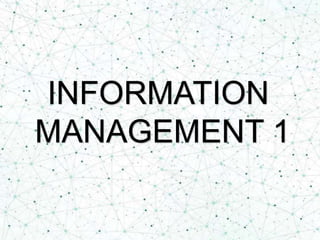
Introduction.pptx
- 8. Study of principles and practices of basic administration (code of conduct)
- 23. Disposition is the disposal of information that has come to the end of the information lifecycle. Most often, this means destruction, though it can also mean transfer to another organization in some cases – for example, to a corporate archive if it has historical value.
- 25. What Are The 5 Key Areas of Information Management? The five key areas of information management are information collection, storage, distribution, archiving, and destruction. Each of these key areas plays a vital role in the effective management of information throughout its lifecycle and ensures that an organization’s information is collected, stored, and shared in a way that supports its operations and decision-making.
- 26. 1- Collection At this stage, we must examine how the business collects information, whether it is created internally or externally, electronically or as paper documents, verbally, written, audio, or video. At this point, it is crucial to collect just the necessary information in order to save storage costs, prevent analyzing data that is unnecessary to business governance, and guarantee that the information obtained is of good quality.
- 27. 2- Storage We must determine where the information collected in the previous phase will be stored. Paper documents should be stored and arranged in physical cabinets with fire-resistance measures in place. Electronic information, on the other hand, might be kept in databases, document management systems, information systems, and so on. We must also identify and configure user access, version and change control, backups, and audit trails.
- 28. 3- Distribution This step entails deciding how different types of information should be distributed, in what format, to whom, how frequently, and through what media, among other things. Information is only valuable when it is presented to the appropriate person in order for the proper action to be taken. This is a critical phase since it helps the overall success of your program.
- 29. 4- Archiving Archiving is the process of securely storing inactive information in any format (both digital and paper) that you no longer use regularly for long-term retention.. Such information is still important to organizations and must be retained for future reference or regulatory compliance. You need to clearly state where the information is going to be archived and for how long.
- 30. 5- Destruction Destruction is the act of disposing of records permanently by obliterating records so that the information in them can no longer be physically or electronically reconstructed or recovered. Destruction decisions must be formally approved before any action is taken.